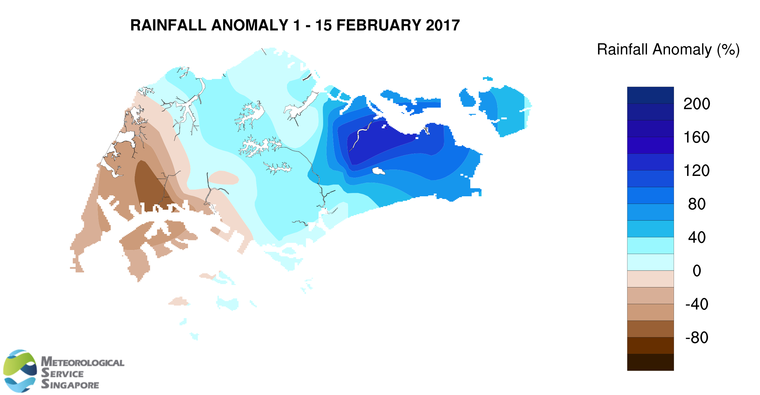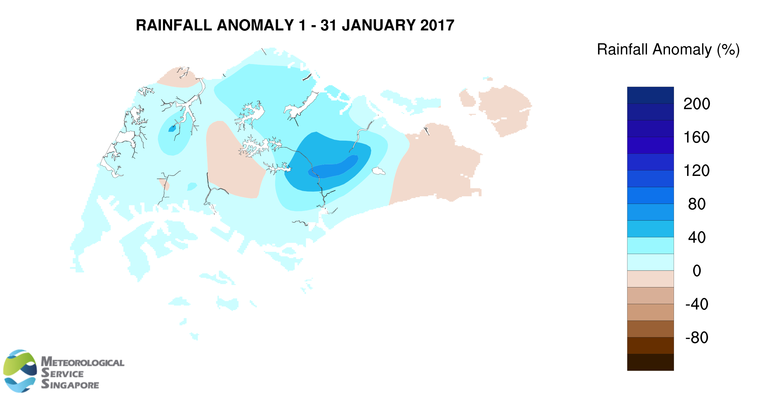Short-duration thundery showers on some afternoons
Singapore, 16 February 2017 – The prevailing dry phase of the Northeast Monsoon is expected to persist in the second half of February 2017, and the low level winds are forecast to blow mostly from the northwest or northeast.
2 The monsoon surge [1] in the South China Sea that that has been affecting Singapore and the surrounding region since 12 February 2017 is expected to weaken in the next one or two days. For the rest of the month, short-duration thundery showers are expected in the afternoon on six to eight days, and could extend into the evening on a few days. The showers may be heavy at times, in particular on days when there is strong solar heating of land areas coupled with convergence of winds over the island or in the surrounding vicinity. The rainfall for February 2017 is expected to be slightly above normal.
3 For the rest of February 2017, the daily temperature on most days is expected to range between 24°C and 33°C. Some warm days can be expected in the later part of the fortnight, when the daily maximum temperature could reach a high of 34°C. However, the daily minimum temperature could dip to around 22°C on rainy days.
4 For updates of the daily weather and haze forecast, please visit our MSS website (https://www.weather.gov.sg), NEA website (www.nea.gov.sg), or download the myENV app, MSS’ Weather@SG app.
REVIEW (1 – 15 February 2017)
5 Singapore experienced Northeast Monsoon conditions in the first half of February 2017. During this period, the low level winds over Singapore and the surrounding region were blowing predominantly from the north or northeast.
6 At the start of February 2017, moderate to heavy thundery showers fell over the island on several afternoons, which extended at times into the evening. The showers were heaviest on 8 February 2017 where the highest daily rainfall total recorded was 108.2mm around the Orchard Road area.
7 The wet weather in the early part of the month was followed by a few days of generally dry and occasionally windy conditions. The drier weather experienced on these days was due to a flow of cold dry air from northern continental Asia toward our surrounding region.
8 The brief spell of dry weather in the second week of the month was broken by the occurrence of a monsoon surge between 12 and 15 February 2017. During this period, Singapore experienced windy and cool conditions, and periods of showers on some days. At the Changi climate station, wind gusts of up to 48.2km/h were recorded during the monsoon surge period. In comparison, the highest ever recorded wind gust for February at the Changi climate station is 64.4km/h. The highest maximum wind gust recorded in February 2017 (as of 16 February 2017) was 67.4km/h at Marina Barrage on 12 February 2017.
9 The daily temperatures in the first half of February 2017 ranged between 22.5°C and 34.1°C. During the monsoon surge episode, the days were windy and cool with the daily minimum temperatures ranging between 22.5°C and 24.6°C.
10 About two-third of the island received above normal rainfall in the first half February 2017. The highest rainfall of 154mm (141% above average) was recorded around Pasir Ris area. Rainfall was lowest around Jurong where 22.8mm (70% below average) was recorded.
[1] A monsoon surge refers to a strengthening of winds over the South China Sea, causing extensive rainclouds to form over our surrounding region.
CLIMATE STATION STATISTICS FOR FEBRUARY (Climatological reference period: 1981 – 2010)
| Mean daily maximum temperature | 32.0 °C |
| Mean daily minimum temperature | 24.3 °C |
| Mean monthly temperature | 27.1 °C |
| Mean rainfall for the month | 112.8 mm |
| Mean number of rain days | 8 |
| Highest monthly mean daily maximum temperature | 33.5 °C (2010) |
| Lowest monthlymean daily minimum temperature | 23.0 °C (1982) |
| Highest monthly rainfall | 470.4 mm (1984) |
| Lowest monthly rainfall | 6.3 mm (2010) |

